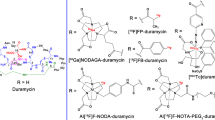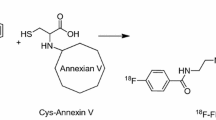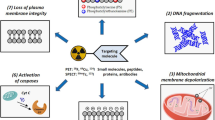Abstract
Apoptosis has a role in many medical disorders and treatments; hence, its non-invasive evaluation is one of the most riveting research topics. Currently annexin V is used as gold standard for imaging apoptosis. However, several drawbacks, including high background, slow body clearance, make it a suboptimum marker for apoptosis imaging. In this study, we radiolabeled the recently identified histone H1 targeting peptide (ApoPep-1) and evaluated its potential as a new apoptosis imaging agent in various animal models. ApoPep-1 (CQRPPR) was synthesized, and an extra tyrosine residue was added to its N-terminal end for radiolabeling. This peptide was radiolabeled with 124I and 131I and was tested for its serum stability. Surgery- and drug-induced apoptotic rat models were prepared for apoptosis evaluation, and PET imaging was performed. Doxorubicin was used for xenograft tumor treatment in mice, and the induced apoptosis was studied. Tumor metabolism and proliferation were assessed by [18F]FDG and [18F]FLT PET imaging and compared with ApoPep-1 after doxorubicin treatment. The peptide was radiolabeled at high purity, and it showed reasonably good stability in serum. Cell death was easily imaged by radiolabeled ApoPep-1 in an ischemia surgery model. And, liver apoptosis was more clearly identified by ApoPep-1 rather than [124I]annexin V in cycloheximide-treated models. Three doxorubicin doses inhibited tumor growth, which was evaluated by 30–40 % decreases of [18F]FDG and [18F]FLT PET uptake in the tumor area. However, ApoPep-1 demonstrated more than 200 % increase in tumor uptake after chemotherapy, while annexin V did not show any meaningful uptake in the tumor compared with the background. Biodistribution data were also in good agreement with the microPET imaging results. All of the experimental data clearly demonstrated high potential of the radiolabeled ApoPep-1 for in vivo apoptosis imaging.







Similar content being viewed by others
References
Taylor RC, Cullen SP, Martin SJ (2008) Apoptosis: controlled demolition at the cellular level. Nat Rev Mol Cell Biol 9:231–241
Jacobson MD, Weil M, Raff MC (1997) Programmed cell death in animal development. Cell 88:347–354
Reed JC (2002) Apoptosis-based therapies. Nat Rev Drug Discov 1:111–121
Hanahan D, Weinberg RA (2011) Hallmarks of cancer: the next generation. Cell 144:646–674
Thompson CB (1995) Apoptosis in the pathogenesis and treatment of disease. Science 267:1456–1462
Yi CH, Yuan J (2009) The Jekyll and Hyde functions of caspases. Dev Cell 16:21–34
Launay S, Hermine O, Fontenay M, Kroemer G, Solary E, Garrido C (2005) Vital functions for lethal caspases. Oncogene 24:5137–5148
Nguyen QD, Challapalli A, Smith G, Fortt R, Aboagye EO (2012) Imaging apoptosis with positron emission tomography: ‘bench to bedside’ development of the caspase-3/7 specific radiotracer [18F]ICMT-11. Eur J Cancer 48:432–440
Smith G, Glaser M, Perumal M (2008) Design, synthesis, and biological characterization of a caspase 3/7 selective isatin labeled with 2-[18F]fluoroethylazide. J Med Chem 51:8057–8067
Nguyen QD, Smith G, Glaser M, Perumal M, Arstad E, Aboagye EO (2009) Positron emission tomography imaging of drug-induced tumor apoptosis with a caspase-3/7 specific [18F]-labeled isatin sulfonamide. Proc Natl Acad Sci USA 106:16375–16380
Blankenberg FG (2008) In vivo detection of apoptosis. J Nucl Med 49(Suppl 2):81S–95S
Niu G, Chen X (2010) Apoptosis imaging: beyond annexin V. J Nucl Med 51:1659–1662
Okarvi SM (2008) Peptide-based radiopharmaceuticals and cytotoxic conjugates: potential tools against cancer. Cancer Treat Rev 34:13–26
Okarvi SM (2004) Peptide-based radiopharmaceuticals: future tools for diagnostic imaging of cancers and other diseases. Med Res Rev 24:357–397
Schottelius M, Wester HJ (2009) Molecular imaging targeting peptide receptors. Methods 48:161–177
Reubi JC, Maecke HR (2008) Peptide-based probes for cancer imaging. J Nucl Med 49:1735–1738
Weiner RE, Thakur ML (2001) Radiolabeled peptides in diagnosis and therapy. Semin Nucl Med 31:296–311
de Jong M, Kwekkeboom D, Valkema R, Krenning EP (2003) Radiolabelled peptides for tumour therapy: current status and future directions. Eur J Nucl Med Mol Imaging 30:463–469
Su H, Chen G, Gangadharmath U, Gomez L, Liang Q, Mu F, Mocharla V, Szardenings A, Walsh J, Xia C-F, Yu C, Kolb H (2013) Evaluation of [18F]-CP18 as a PET imaging tracer for apoptosis. Mol Imaging Biol 15(6):739–747
Doss M, Kolb HC, Walsh JC, Mocharla V, Fan H, Chaudhary A, Zhu Z, Alpaugh RK, Lango MN, Yu JQ (2013) Biodistribution and radiation dosimetry of 18F-CP-18, a potential apoptosis imaging agent, as determined from PET/CT scans in healthy volunteers. J Nucl Med 54(12):2087–2092
Wang K, Purushotham S, Lee J-Y, Na M-H, Park H, Oh S-J, Park R-W, Park JY, Lee E, Cho BC, Song M-N, Baek M-C, Kwak W, Yoo J, Hoffman AS, Oh Y-K, Kim I-S, Lee B-H (2010) In vivo imaging of tumor apoptosis using histone H1-targeting peptide. J Control Release 148:283–291
Keen HG, Dekker BA, Disley L, Hastings D, Lyons S, Reader AJ, Ottewell P, Watson A, Zweit J (2005) Imaging apoptosis in vivo using 124I-annexin V and PET. Nucl Med Biol 32(4):395–402
Hamacher K, Coenen HH, Stoecklin G (1986) Efficient stereospecific synthesis of no-carrier-added 2-[18F]-fluoro-2-deoxy-d-glucose using aminopolyether supported nucleophilic substitution. J Nucl Med 27:235–238
Yun M, Oh SJ, Ha H-J, Ryu JS, Moon DH (2003) High radiochemical yield synthesis of 3′-deoxy-3′-[18F]fluorothymidine using (5′-O-dimethoxytrityl-2′-deoxy-3′-O-nosyl-β-D-threo pentofuranosyl)thymine and its 3-N-BOC-protected analogue as a labeling precursor. Nucl Med Biol 30:151–157
Cai H, Li Z, Huang C-W, Shahinian AH, Wang H, Park R, Conti PS (2010) Evaluation of copper-64 labeled AmBaSar conjugated cyclic RGD peptide for improved MicroPET imaging of integrin αvβ3 expression. Bioconjugate Chem 21(8):1417–1424
Pandya DN, Bhatt N, An GI, Ha YS, Soni N, Lee H, Lee YJ, Kim JY, Lee W, Ahn H, Yoo J (2014) Propylene cross-bridged macrocyclic bifunctional chelator: a new design for facile bioconjugation and robust 64CU complex stability. J Med Chem 57(17):7234–7243
Zuckier LS, Li Y, Chang CJ (1998) Evaluation in a mouse model of a thyroid-blocking protocol for 131I antibody therapy (short communication). Cancer Biother Radiopharm 13(6):457–460
Ha YS, Lee HY, An GI, Kim J, Kwak W, Lee E-J, Lee S-M, Lee B-H, Kim I-S, Belay T, Lee W, Ahn B-C, Lee J, Yoo J (2012) Synthesis and evaluation of a radioiodinated bladder cancer specific peptide. Bioorg Med Chem 20(14):4330–4335
Wolf H, Marschall F, Scheffold N, Clausen M, Schramm M, Henze E (1993) Iodine-123 labelling of atrial natriuretic peptide and its analogues: initial results. Eur J Nucl Med 20:297–301
Russell J, O’Donoghue JA, Finn R, Koziorowski J, Ruan S, Humm JL, Ling CC (2002) Iodination of annexin V for imaging apoptosis. J Nucl Med 43:671–677
Zaccagnini G, Martelli F, Fasanaro P (2004) p66ShcA modulates tissue response to hindlimb ischemia. Circulation 109:2917–2923
Ledda-Columbano GM, Coni P, Faa G, Manenti G, Columbano A (1992) Rapid induction of apoptosis in rat liver by cycloheximide. Am J Pathol 140:545–549
Lu X, Hamilton JA, Shen J, Pang T, Jones DL, Potter RF, Arnold JMO, Feng Q (2006) Role of tumor necrosis factor-α in myocardial dysfunction and apoptosis during hindlimb ischemia and reperfusion. Crit Care Med 34:484–491
Kelloff GJ, Hoffman JM, Johnson B (2005) Progress and promise of FDG-PET imaging for cancer patient management and oncologic drug development. Clin Cancer Res 11:2785–2808
Been LB, Suurmeijer AJ, Cobben DC, Jager PL, Hoekstra HJ, Elsinga PH (2004) [18F]FLT-PET in oncology: current status and opportunities. Eur J Nucl Med Mol Imaging 31:1659–1672
Jensen MM, Erichsen KD, Bjorkling F (2010) Early detection of response to experimental chemotherapeutic Top216 with [18F]FLT and [18F]FDG PET in human ovary cancer xenografts in mice. PLoS One 5:e12965
Bakker WH, Krenning EP, Breeman WA (1990) Receptor scintigraphy with a radioiodinated somatostatin analogue: radiolabeling, purification, biologic activity, and in vivo application in animals. J Nucl Med 31:1501–1509
Lederle W, Arns S, Rix A (2011) Failure of annexin-based apoptosis imaging in the assessment of antiangiogenic therapy effects. EJNMMI Res 1:26
Hu S, Kiesewetter DO, Zhu L (2012) Longitudinal PET imaging of doxorubicin-induced cell death with 18F-Annexin V. Mol Imaging Biol 14:762–770
Albertsson P, Lennernas B, Norrby K (2003) Chemotherapy and antiangiogenesis: drug-specific effects on microvessel sprouting. APMIS 111:995–1003
Acknowledgments
This work was supported by R&D program through the National Research Foundation of Korea funded by the Ministry of Science, ICT & Future Planning (Nos. 2013R1A2A2A01012250, 2013M2A2A6042317, 2012-0006386, 20090078235) and the Basic Research Laboratory (BRL) Program (2013R1A4A1069507). The Korea Basic Science Institute (Daegu) is acknowledged for the NMR and MS measurements.
Author information
Authors and Affiliations
Corresponding authors
Additional information
Wonjung Kwak, Yeong Su Ha and Nisarg Soni have contributed equally to this work.
Rights and permissions
About this article
Cite this article
Kwak, W., Ha, Y.S., Soni, N. et al. Apoptosis imaging studies in various animal models using radio-iodinated peptide. Apoptosis 20, 110–121 (2015). https://doi.org/10.1007/s10495-014-1059-z
Published:
Issue Date:
DOI: https://doi.org/10.1007/s10495-014-1059-z




